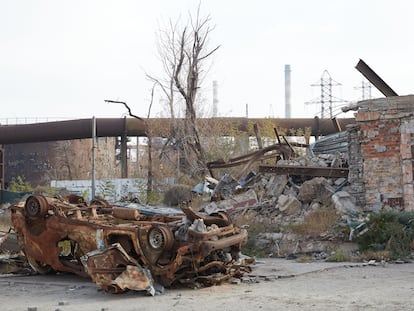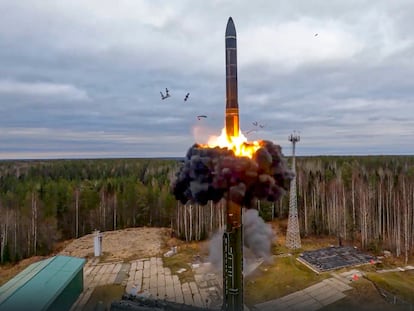Russia launches large-scale attack on Ukraine’s energy system in retaliation for Western missile use
Vladimir Putin justified the strikes as a response to the Ukrainian use of US weapons against Russian territory and threatened Kyiv with the experimental hypersonic missile used on November 21

Russia is continuing its winter bombing campaign against Ukraine’s energy network. On Thursday morning the Kremlin launched an attack with 90 missiles and 97 drone bombs targeting civilian infrastructure in a dozen provinces across the country. Power companies have introduced cuts in Ukrainian cities, a move that is precisely what Moscow has been pursuing since the fall of 2022: leaving millions of Ukrainians without electricity and other basic services such as heating or hot water in the cold months.
Hours after the attack, Russian President Vladimir Putin said at a conference in Kazakhstan that the strikes are a response to the Ukrainian army’s use of U.S. and U.K. long-range missiles against targets on Russian soil. Putin indicated that the main target was 17 military installations and threatened to use the Oreshnik — an experimental missle designed for nuclear warfare and used for the first time last week against military installations in Dnipro — on the Ukrainian capital. “It could be military facilities, defense industry enterprises, or decision-making centers in Kyiv,” the Russian leader said.
Thursday’s offensive knocked out power to 523,000 consumers in the Lviv region, some 215,000 in Volhynia and more than 280,000 in Rivne, according to the provisional balance sheet of regional authorities. “The energy sector is again under massive enemy attack. Attacks are taking place all over the country. The [power grid] operator Ukrenergo has introduced emergency blackouts,” Energy Minister Herman Galushchenko wrote in a brief statement early Thursday morning. From 5 a.m. to 8:30 a.m., the Russian military fired missiles and drones at infrastructure in a dozen provinces. Damage to civilian buildings has been reported in Kyiv and Odesa.
The Ukrainian Air Force reported intercepting 79 of the missiles and 35 drones. The Monitor military information account on Telegram, which specializes in tracking bombings, has summarized that the Russian operation consisted of two phases: a first in which the Russian fleet in the Black Sea launched Kalibr cruise missiles, and a second in which Kinzhal cruise missiles fired by bombers from the Russian province of Volgograd and from the Crimean peninsula — illegally annexed by the Kremlin in 2014 — were used.
Volodymyr Zelenskiy stressed in a message on his social networks that Russia has used cluster munitions, which, although they produce less powerful explosions, spread more damage and further complicate the repair of civilian infrastructure. “This is a vile escalation of Russian terrorist tactics,” the Ukrainian president said. Zelenskiy insisted on the need to receive more anti-aircraft defense systems from Kyiv’s Western allies: “These defense systems are needed now in Ukraine, where they save lives, and not in warehouses.”
The Energy Ministry reported that this is the 11th large-scale Russian bombing of the energy network so far this year. The United Nations estimates that Ukraine has lost 60% of its power generation capacity.
The previous bombardment of these dimensions took place on November 17 and followed the same parameters of schedule, time, and weaponry as Thursday’s, although on that occasion the arsenal used was larger, with 120 missiles and 90 Shahed drone bombs.
Putin’s hypersonic missile threat
The Russian offensive against Ukraine’s energy system coincides with a new phase of the war in which the Kremlin has threatened Kyiv and its NATO partners with serious consequences if the Ukrainian army continues to use Western long-range missiles against military targets inside Russia. Putin ordered the launch of the Oreshnik, an intermediate-range hypersonic ballistic missile, against a military plant in the city of Dnipro on November 21. This is the first time such a rocket has been used in an armed conflict.
The Russian president took advantage of a meeting of the Collective Security Treaty Organization (CSTO), the Russian alternative to NATO, to raise his threat to the West. “Due to its striking power, especially when used en masse and in combination with other long-range precision systems that Russia also has, using it against enemy targets will be comparable in effect and power to using strategic weapons,” Putin said a few days ago.
The Russian president declared that his General Staff and Defense Ministry are selecting new targets for this missile, although he spoke conditionally when mentioning them: “They could be decision-making centers in Kyiv.” Moreover, he justified bombing the Ukrainian government because it exercises power in an acting capacity due to not being able to hold normal elections because of the Russian invasion.
“They are completely illegitimate today. From the legal point of view, they do not even have the right to give orders to the armed forces, because they are usurpers of power,” said Putin on Thursday. The Russian president renewed his mandate until 2030 in March in an election in which he vetoed any opposition candidacy and which was not scrutinized by independent international observers, such as the OSCE mission.
However, Putin’s bluster is not new. He issued the same threat in June 2022, at the beginning of the war, when Europe was hesitating about whether to send arms to Ukraine: “As for the red lines, let me keep them to myself because it will mean rather harsh actions against the decision-making centers. But this should be decided by the Russian military-political leadership. That is, the Defense Ministry,” the Russian leader said at the time.
Ukraine staged a partial occupation of the Russian province of Kursk last August. Since then, it has lost 40% of the conquered ground, but Zelenskiy’s goal is to remain in Kursk in the long term, to show that Russia is vulnerable on its own territory. To this end, in November, Kyiv obtained U.S., British and French authorization for the use of long-range ATACMS, Storm Shadow, and Scalp missiles against Russian military targets on enemy soil.
Putin also affirmed that his war industry produces 10 times more missiles than all NATO countries combined and in 2025 “their production will increase by another 25% or 30%.” He also explained the destructive power of his new Oreshnik missile: “The temperature of the damaging elements of the Oreshnik allegedly reaches 4,000 degrees,” he said Thursday. “Everything in the epicenter of the explosion is divided into fractions, elementary particles, and essentially turns into dust.”
Sign up for our weekly newsletter to get more English-language news coverage from EL PAÍS USA Edition
Tu suscripción se está usando en otro dispositivo
¿Quieres añadir otro usuario a tu suscripción?
Si continúas leyendo en este dispositivo, no se podrá leer en el otro.
FlechaTu suscripción se está usando en otro dispositivo y solo puedes acceder a EL PAÍS desde un dispositivo a la vez.
Si quieres compartir tu cuenta, cambia tu suscripción a la modalidad Premium, así podrás añadir otro usuario. Cada uno accederá con su propia cuenta de email, lo que os permitirá personalizar vuestra experiencia en EL PAÍS.
¿Tienes una suscripción de empresa? Accede aquí para contratar más cuentas.
En el caso de no saber quién está usando tu cuenta, te recomendamos cambiar tu contraseña aquí.
Si decides continuar compartiendo tu cuenta, este mensaje se mostrará en tu dispositivo y en el de la otra persona que está usando tu cuenta de forma indefinida, afectando a tu experiencia de lectura. Puedes consultar aquí los términos y condiciones de la suscripción digital.
More information
Archived In
Últimas noticias
Most viewed
- Reinhard Genzel, Nobel laureate in physics: ‘One-minute videos will never give you the truth’
- Oona Chaplin: ‘I told James Cameron that I was living in a treehouse and starting a permaculture project with a friend’
- Pablo Escobar’s hippos: A serious environmental problem, 40 years on
- Why we lost the habit of sleeping in two segments and how that changed our sense of time
- Charles Dubouloz, mountaineering star, retires at 36 with a farewell tour inspired by Walter Bonatti











































